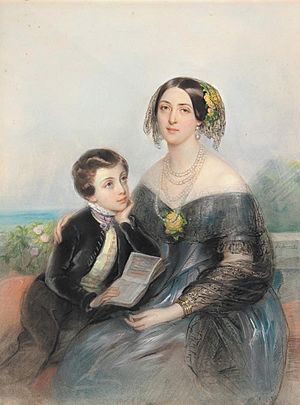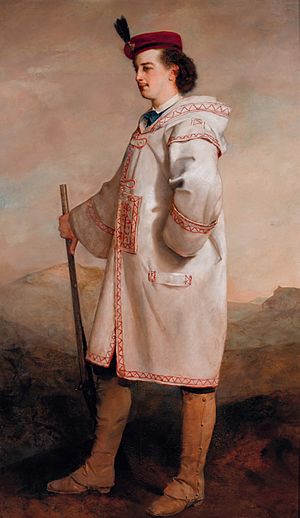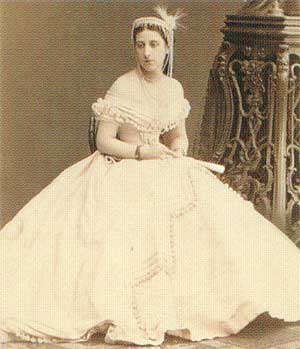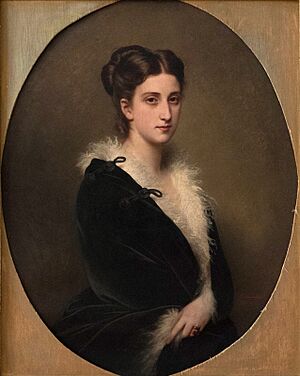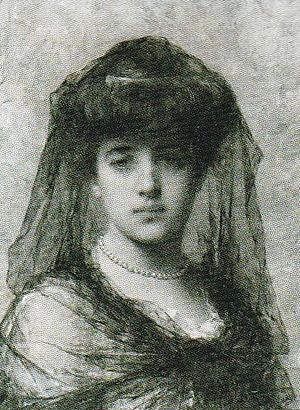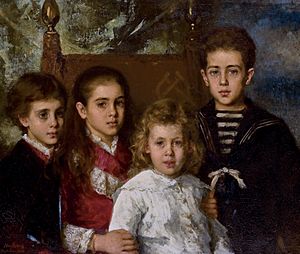Pavel Pavlovich Demidov, 2nd Prince of San Donato facts for kids
Quick facts for kids Pavel Pavlovich Demidov |
|
|---|---|
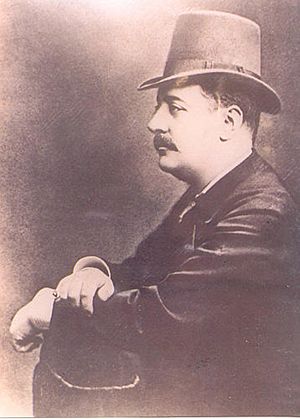 |
|
| Prince of San Donato | |
| Reign | 1870–1885 |
| Predecessor | Anatoly Demidov |
| Successor | Elim Demidov |
| Born | 9 October 1839 |
| Died | 26 January 1885 Pratolino, Florence |
| Spouse | Mariya Meshcherskaya Princess Hélène Petrovna Trubetskaya |
| Issue | Elim Palvlovich Demidov Nikita Pavlovich Demidov Aurora Pavlovna Demidova Antoly Pavlovich Demidov Maria Pavlovna Demidova Pavel Pavlovich Demidov Elena Pavlovna Demidova |
| House | Demidov |
| Father | Pavel Nikolaievich Demidov |
| Mother | Aurora Karamzin |
Pavel Pavlovich Demidov (born October 9, 1839 – died January 26, 1885) was a very important Russian nobleman. He was known as the 2nd Prince of San Donato. Pavel was a successful businessman who owned many factories. He was also a legal expert and someone who loved to help others. He belonged to the famous Demidov family. His mother was Aurora Karamzin, a kind person from Finland, and his father was Prince Pavel Nikolaievich Demidov.
Contents
Life of Pavel Demidov
Early Years and Education
Pavel Pavlovich was only six months old when his father passed away. He grew up to be a lively and sensitive young man. His mother, Aurora, carefully planned his education. She hired experts to teach him different subjects.
From a young age, Pavel loved horses. He took riding lessons and even got to ride the horse of a Grand Duchess. This was because his mother was very close to the Imperial family in Russia.
In 1860, Pavel earned a law degree in St. Petersburg. He worked for the government for a short time. He even served as a special secretary for Russian groups in Vienna and Paris.
Pavel's uncle, Anatole Demidov, lived in Florence. To make sure his valuable art collection and other family properties stayed safe, Anatole made Pavel his only heir. King Victor Emanuel II of Italy agreed that Pavel could inherit the title of Prince of San Donato. The Russian Emperor, Alexander II, also gave Pavel this title in Russia. Pavel also became an Imperial Master of the Hunt and a Privy Councillor, just like his father.
Challenges and Changes
When Pavel was a young man, he was known for being charming but also very proud. Spending time with his uncle Anatole wasn't always good for him. He started living a very expensive lifestyle in Paris.
Pavel often got into trouble because of his quick temper. His mother, Aurora, even had to help him out of difficult situations. She moved to Paris for a few winters to try and guide her son. To help pay off his large debts, she had to sell a very valuable diamond. This diamond, called Le Grand Sancy, was a gift from Pavel's father to her.
In 1862, Pavel took over the family businesses. His uncle Anatole had already left the company. However, the company's profits started to drop. This was partly because Pavel spent a lot of money and wasn't very interested in running the businesses.
Another big reason for the financial problems was the end of serfdom in Russia in 1861. This meant that mining companies lost their free workers. They now had to pay workers, which increased costs. As things got worse, his mother Aurora had to step in to help manage the company again.
Pavel had to sell his mansion in Paris and his luxurious villa in Deauville. The family's palace in Saint Petersburg was rented out and later sold. Things became so difficult that some of Aurora's valuable pearls had to be used as security for the company's large debt.
However, when his uncle Anatole Demidov passed away in 1870, the family's financial situation improved. This was because Anatole's large yearly payment no longer had to be paid by the company.
Family Life
Pavel's life changed when he fell in love with Princess Maria Mescherskaya. They met in Paris in 1867. They married on June 1, 1867. Sadly, Maria passed away on August 8, 1868, just two days after giving birth to their son, Elim.
Losing his wife deeply affected Pavel. He was heartbroken for a long time. His mother, Aurora, took care of little Elim, who became very close to his grandmother.
To honor his wife's memory, Pavel created a workplace for 200 women in Paris. He wanted to help improve the lives of working-class people. In 1869, he was appointed to a government role in Kyiv. He did well and became mayor a year later.
After his uncle Anatole died in 1870, Pavel left his government job. He moved to Florence to live as the Prince of San Donato. He took over the mansion near San Donato with its valuable art collections.
Pavel married a second time on June 2, 1871, to Princess Elena (Hélène) Petrovna Trubetskaya. They had six children together:
- Prince Nikita Pavlovich Demidov (1872–1874), who passed away as a child.
- Princess Aurora Pavlovna Demidova (1873–1904), who later married Prince Arsen of Yugoslavia.
- Anatoly Pavlovich Demidov, 4th Prince of San Donato (1874–1943).
- Princess Maria Pavlovna Demidova (1877–1955).
- Prince Pavel Pavlovich Demidov (1879–1909).
- Princess Elena Pavlovna Demidova (1884–1959).
Pavel felt that San Donato reminded him too much of his first wife. So, in 1873, he bought a large estate called Pratolino. He spent millions restoring it. Once the castle-like Villa Pratolino, now known as Villa Demidoff, was ready, Pavel and his family moved there.
They eventually sold San Donato and its famous art collection. Many of the artworks from the large Demidov collection were sold at public auctions.
Helping Others and Supporting Arts
Pavel Demidov followed his family's tradition of helping others. He was respected in Russia, Italy, and France for his charity work. He supported schools, universities, libraries, hospitals, and places that helped single mothers. He also helped improve the cities of Kyiv and Florence.
Thanks to him, the Cathedral of Santa Maria del Fiore in Florence was finally completed. You can even see Pavel Demidov's family crest on the cathedral's front, near the main entrance.
Pavel was one of the richest men in Europe. He owned hundreds of factories in Russia, millions of square kilometers of land, and palaces in Russia, France, and Italy. He helped grow the family's wealth. He also served with the Red Cross during the Russo-Turkish War instead of joining the military. In 1883, he published a book that supported Jewish people in Russia.
Pavel Demidov passed away at the age of 45 due to a serious illness. He was buried in the Demidov family tomb in Nizhny Tagil.
After Pavel's death, his wife, Hélène Trubetskaya, took over managing the family company. This was because all their children were still young. The family's property was divided in 1887. Despite many challenges, the Nizhny Tagil mining and factory area stayed with the family until 1917.


